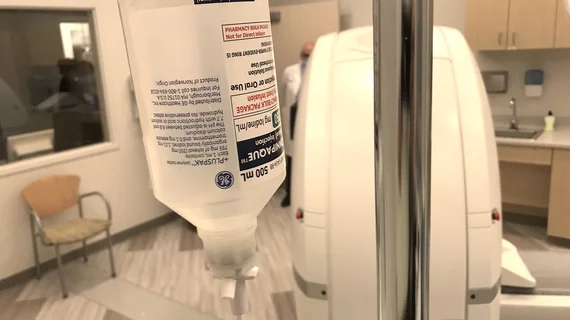Have we been 'overdependent' on iodinated contrast? New paper calls into question prior practices before the shortage
A new paper published in Emergency Radiology offers additional tips and insight to preserve iodinated contrast supplies, while also calling into question prior practices that might have resulted in the imaging agent’s overuse.
The iodinated contrast shortage is yet another notch in COVID’s ever expanding belt that has had a chokehold on the healthcare system for more than two years now. And although COVID is undeniably the root of the issue, it has also provided ample opportunities for clinicians to seek solutions to practices that might have perhaps needed addressing long before the crisis was considered acute.
“This is not the first shortage, and it would not be the last, thus it is imperative that we identify alternative measures to decrease the effects of this supply shortage and provide recommendations for how hospitals and clinicians can adapt in the absence of iodinated contrast media,” wrote co-authors Ali Gholamrezanezhad and Liesl S. Eibschutz, both from the Department of Radiology at the Keck School of Medicine, University of Southern California.
While devising preservation strategies, many experts in the field have analyzed the appropriate use of imaging protocols that utilize ICM, questioning whether using contrast adds any benefit at all in certain situations and whether it could be substituted in others. The authors of the paper point out that for a great deal of patients who would have routinely undergone contrast-enhanced imaging before the shortage, their outcomes and management would not have been impacted by an enhanced study.
“This begs the question whether we have been overusing iodinated contrast media, as in many cases, patient management would remain unchanged even if the diagnosis is only visible on contrast-enhanced CT. Ultimately, long-term studies are vital to parse out whether the absence of iodinated contrast media greatly affected patient outcomes or if we have been overdependent on ICM unnecessarily.”
In terms of mitigation tactics, the authors touched on the use of spectral and dual energy CT exams, noting that their use can lower the amount of contrast required to produce suitable imaging. They added that additional modalities and adjustments that merit consideration include substituting CT angiography for MR angiography in hemodynamically stable patients, MRI with gadolinium contrast and FDG PET/CT scans for follow-up scans of cancer patients with FDG-avid tumors. The ACR appropriateness criteria has additional information on suitable exam substitutions.
However, before any image modalities and/or protocols can be altered, pertinent information on available supplies must be effectively communicated throughout institutions as a whole—from radiologists to referring providers, administrative staff, patients and beyond—everyone should be kept up to date on each institution’s status. This should be the first step, the authors said, before suggesting that communicating changes as a cohesive system can spare patients and providers before inconveniences venture too far.
In the end, the authors maintain that this shortage will likely not be the last; that current strategies to blunt the impact in the interim will not suffice in the long-term, and that there is more work to be done.
“Ultimately, further research should be obtained on the imaging studies that have been conducted over the course of the ICM shortage, in order to determine if these policies surrounding contrast use affected patient management or compromised patient outcome.”
The full paper is available here.

